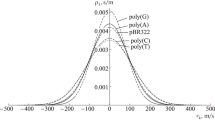Abstract
A physical interpretation of the Topal-Fresco [Nature 263, 285 (1976)] model for spontaneous base substitutions suggests that hydrogen-bonded DNA protons satisfy the criteria for a classical noninteracting isolated system. Accessible states for duplex G-C protons include the keto-amino state and the six complementary enol-imine isomers. Hydrogen-bonded enol and imine protons occupy symmetric double-minima created by the two sets of indistinguishable electron lone pairs and a single proton belonging to each enol-imine end group. These protons will consequently participate in coupled quantum mechanical flip-flop, tunneling back and forth between symmetric energy wells. This results in a quantum mixing of proton energy states where the lowest energy state will be a linear combination of available G-C isomers. The resulting conclusion is that metastable keto-amino G-C protons will populate accessible enol-imine stationary states at rates governed by quantum laws of statistical equilibrium, consistent with achieving the lowest energy condition for duplex G-C protons. Enol-imine G-C stationary states are bound more tightly, of the order of 3 to 12 kcal/mol, which requires a modified mode of Topal-Fresco replication that will inhibit reequilibration of enol and imine G and C template isomers and, thus, promote the formation of complementary mispairs. The model is demonstrated on time-dependent base substitutions expressed by T4 phage DNA systems where data are consistent with model explanations, including the prediction that time-dependent evolutionary transversion sites will exhibit both G-C-to-T-A and G-C-to-C-G transversions at replication, due to proton flip-flop alteration of G template genetic specificity. The observation that A-T sites are resistant to time-dependent evolutionary base substitutions, expressed exclusively at G-C sites, allows codons to be classified as either evolutionary sensitive (16 codons) or evolutionary resistant (8 codons). These criteria provide possible explanations for expansion properties of the CGG fragile X sequences. Enol-imine G-C stationary states appear to have been misdiagnosed as deamination of cytosine and oxidation of guanine to 8-hydroxyguanine.
Similar content being viewed by others
References
Baltz, R. H., Bingham, P. M., and Drake, J. W. (1976). Heat mutagenesis in bacteriophage T4: The transition pathway.Proc. Natl. Acad. Sci. USA 731269.
Bell, R. P. (1981).Proton Tunneling in Chemistry Chapman and Hall, London.
Benzer, S. (1961). On the topography of the genetic fine structure.Proc. Natl. Acad. Sci. 47403.
Bingham, P. M., Baltz, R. H., Ripley, L. S., and Drake, J. W. (1976). Heat mutagenesis in bacteriophage T4: The transversion pathway.Proc. Natl. Acad. Sci. USA 734159.
Britten, R. J. (1986). Rates of DNA sequence evolution differ between taxonomic groups. Science2311393.
Brown, W. M., Prager, E. M., Wang, A., and Wilson, A. C. (1982). Mitochondrial DNA sequences of primates: Tempo and mode of evolution.J. Mol. Evol. 18225.
Caldin, E. F. (1964).Fast Reactions in Solution Blackwell, Oxford, p. 268.
Cooper, W. G. (1979). Proton transitions in hydrogen bonds of DNA: A first order perturbation model.Int. J. Quantum Chem. Quantum Biol. Symp. 6171.
Cooper, W. G. (1993). Roles of evolution, quantum mechanics and point mutations in origins of cancer.Cancer Biochem. Biophys. 13147.
Cooper, W. G. (1994a). Consequences of quantum mechanical proton bonds in duplex G-C DNA (submitted for publication).
Cooper, W. G. (1994b). Hypothesis on a causal link between EMF and an evolutionary class of cancer and spontaneous abortion (submitted for publication).
Feynman, R. P., Leighton, R. B., and Sands, M. (1965).The Feynman Lectures on Physics, Vol. III Addison-Wesley, Reading, MA.
Fu, Y. H., Kuhl, D. P. A., Pizzuti, A.,et al. (1991). Variation of the CGG repeat at the fragile X site results in genetic instability: Resolution of the Sherman paradox.Cell 671047.
Hameka, H. F., and de la Vega, J. R. (1984). Intramolecular proton exchange in near symmetric cases.J. Am. Chem. Soc. 1067703.
Horai, S., Satta, Y., Hayasaka, K.,et al. (1992). Man's place in hominoidea revealed by mitochondria DNA genealogy.J. Mol. Evol. 3532.
Irwin, D. L., Kocher, T. D., and Wilson, A. C. (1991). Evolution of the cytochromeb gene of mammals.J. Mol. Evol. 32128.
Kricker, M., and Drake, J. W. (1990). Heat mutagenesis in bacteriophage T4: Another walk down the transversion pathway.J. Bact. 1723037.
Lehninger, A. L. (1970).Biochemistry Worth, New York, p. 653.
Lindahl, T. (1993). Instability and decay of the primary structure of DNA.Nature 362709.
Löwdin, P. O. (1965). Quantum genetics and the aperiodic solid: Some aspects on the biological problems of heredity, mutations, aging and tumors in view of the quantum theory of the DNA molecule.Adv. Quantum Chem. 2213.
Martin, A. P., Naylor, G. J. P., and Palumbi, S. R. (1992). Rates of mitochondria DNA evolution in sharks are slow compared with mammals.Nature 357153.
Merzbacher, E. (1970).Quantum Mechanics 2nd ed., Wiley, New York.
Meschede, L., and Limbach, H. H. (1991). Dynamic NMR study of the kinetic HH/HD/DD isotope effects on the double proton transfer in cyclic bis(p-fluorophenyl)formamidine dimers.J. Phys. Chem. 9510267.
Okuyama, S., and Oxtoby, D. W. (1988). A two-dimensional model for a light particle tunneling system.J. Chem. Phys. 882405.
Reif, F. (1965).Fundamentals of Statistical and Thermal Physics McGraw-Hill, New York.
Saykally, R. J., and Blake, G. A. (1993). Molecular interactions and hydrogen bond tunneling dynamics: Some new perspectives.Science 2591570.
Shields, G. F., and Wilson, A. C. (1987). Calibration of mitochondrial DNA evolution in geese.J. Mol. Evol. 24212.
Sinha, N. K., and Haimes, M. D. (1981). Molecular mechanism of spontaneous base substitution mutations: An experimental test of the Watson-Crick and Topal-Fresco models of base mispairings.J. Biol. Chem. 25610671.
Topal, M. D., and Fresco, J. R. (1976). Origin of base substitutions.Nature 263285.
Vawter, L., and Brown, W. M. (1986). Nuclear and mitochondrial DNA comparisons reveal extreme rate variation in the molecular clock.Science 234194.
Watson, J. D., Hopkins, N. H., Roberts, J. W., Steitz, J. A., and Weiner, A. M. (1987).Molecular Biology of the Gene 4th ed., Benjamin/Cummings, Menlo Park, CA.
Zuckerkandl, E. (1987). On the molecular clock.J. Mol. Evol. 2634.
Author information
Authors and Affiliations
Rights and permissions
About this article
Cite this article
Cooper, W.G. T4 phage evolution data in terms of a time-dependent Topal-Fresco mechanism. Biochem Genet 32, 383–395 (1994). https://doi.org/10.1007/BF00566059
Received:
Revised:
Issue Date:
DOI: https://doi.org/10.1007/BF00566059




